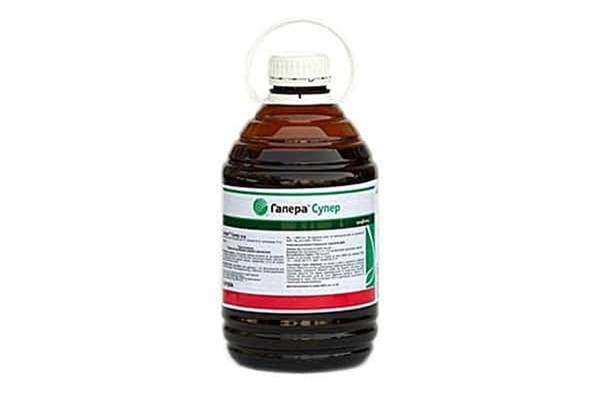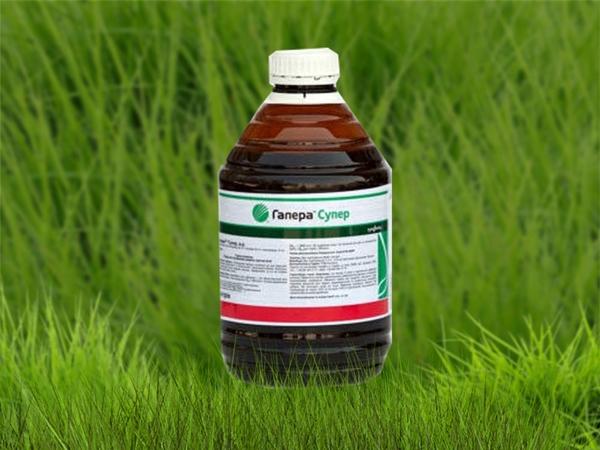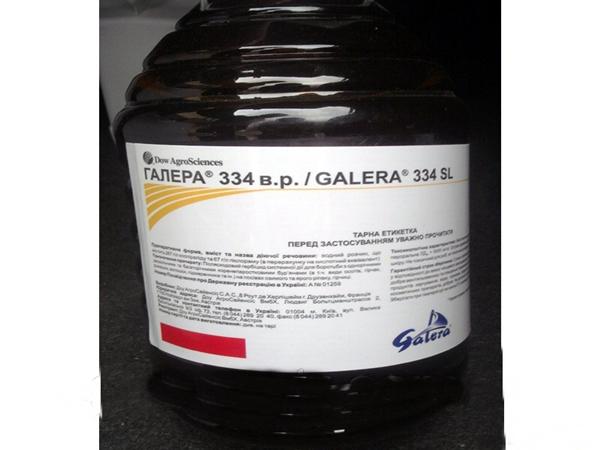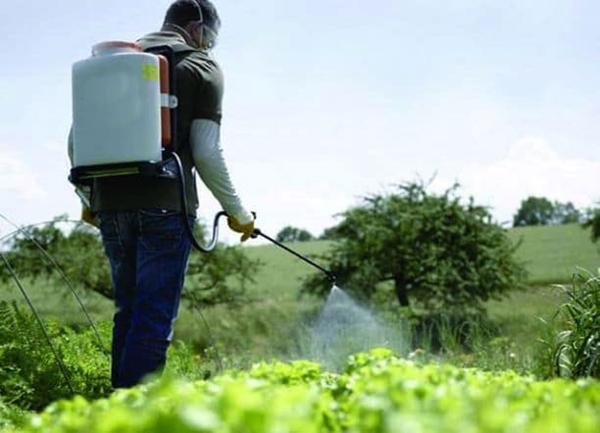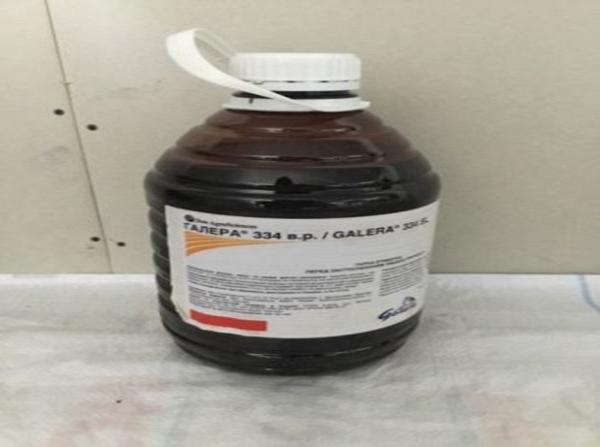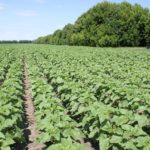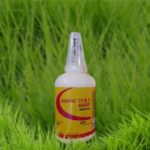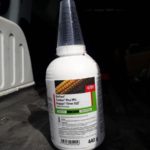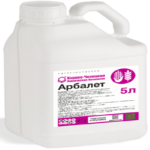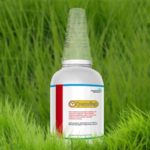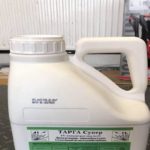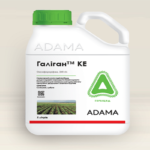Systemic herbicide Galera is used to control annual and perennial dicotyledonous weeds. The drug has selective properties, destroys only weeds and does not harm the main crop (rapeseed, mustard, grains, corn). The herbicide is used only once per season, at the beginning of the growing season.
- Composition, release form and purpose of the herbicide Galera
- Mechanism of action of the drug
- Pros and cons of the product
- Consumption measures
- How to prepare a working mixture
- Instructions for use of the prepared solution
- Safety precautions for use
- Compatibility and toxicity
- How to properly store the drug
- Similar means
Composition, release form and purpose of the herbicide Galera
This is a two-component systemic herbicide with selective action. It is used on rapeseed, soybean, mustard, grain and corn crops. Destroys annual and perennial dicotyledonous weeds, including chamomile, thistle, sow thistle, cornflowers, acorn grass, bedstraw, dandelion, henbane, and ragweed.
This herbicide contains two active ingredients: clopyralid and picloram. The drug is produced under license from the American company Dow AgroSciences. The herbicide is in the form of an aqueous solution. Packaging: 5 liter plastic bottle.
Mechanism of action of the drug
The herbicidal agent Galera is dissolved in water in the dosage specified in the instructions. Weeds are irrigated with dissolved pesticide at the very beginning of growth. The drug is used for post-emergence treatment of main crops.
The active substances of the Galera herbicide are synthetic forms of plant hormones and act only on weeds. The drug penetrates into the plant through the leaves and roots and is distributed throughout all its organs.
A few hours after application, the weeds stop growing. The first visible signs of damage (deformation of leaves, stems, curling, chlorosis) are noticeable after a day.
Weeds die completely within 1-3 weeks.
Pros and cons of the product
Advantages of Galera herbicide:
- can be used after germination of the main crop;
- has a systemic and selective effect;
- provides long-term protection against weeds;
- quickly begins to act;
- destroys the root system of root shoot weeds;
- compatible with anti-cereal herbicides.
Disadvantages of the drug:
- not used at temperatures below 8 and above 25 degrees Celsius;
- with prolonged use, resistance may develop.
Consumption measures
Galera herbicide is used in the following dosages (at a working fluid consumption of 200-300 l/ha):
- For the destruction of annual dicotyledons: 300 ml/ha.
- For the destruction of perennial dicotyledons and in late periods: 350 ml/ha.
How to prepare a working mixture
The solution is prepared from the herbicide and clean, soft, free of impurities water. To spray the field, use a fine sprayer of any brand.
First, a matrix solution is prepared in a plastic container. Take the required amount of the drug for the volume of the sprayer tank and dissolve it in water. The solution is thoroughly mixed. Then fill the sprayer tank halfway with water. The matrix mixture is poured with the stirrer turned on. The herbicide should dissolve well. Then the mixer is turned off and the required amount of water is added.
Instructions for use of the prepared solution
A herbicidal solution prepared from water and the preparation Galera or Galera Super is used for post-emergence (in the phase of 3 true leaves) treatment of main crops (before the appearance of flower buds in rapeseed). The herbicide kills newly emerging weeds.
Galera is effective on heavily weeded crops and fights weeds in the later stages of development.
The drug is used at ambient temperatures from 8 to 25 degrees Celsius. It is prohibited to treat staple crops weakened by frost, diseases, insects, or lack of nutrients. The herbicide solution is not applied to wet weeds, that is, in the early morning before the dew has dried, or immediately after rain.
One treatment with this herbicide is carried out per season (in early spring, at the very beginning of the growing season). Irrigate the field in dry and windless weather.Dissolved chemicals will have time to penetrate the weeds if it rains 1 hour after spraying.
Safety precautions for use
When working with herbicide solution, you must adhere to safety precautions. It is prohibited to inhale vapors or drink herbicide dissolved in water. The person irrigating the field must wear a protective suit, respirator or mask, rubber boots and gloves. After field work, you need to wash your face and hands with warm water and soap, and rinse your mouth with a soda solution.
Compatibility and toxicity
The chemical preparation Galera can be used with anti-cereal herbicides, insecticides, and fungicides for complex field treatment. The drug is used in mixtures with growth regulators and liquid fertilizers. All chemicals must be tested for physical miscibility. When using several drugs together, the dosage of each is reduced.
The herbicide Galera has been assigned hazard class 3. The drug is safe for humans, animals, birds, and beneficial soil insects. It is not advisable to spray the field during the active summer of bees. Aerial treatment is prohibited in the protected zone of water bodies. If the dosages of the herbicide recommended in the instructions are followed, phytotoxicity towards main crops is not observed.
How to properly store the drug
Galera herbicide must be used before the expiration date. The drug can be stored for no more than 2 years from the date of manufacture. For this pesticide, a separate room is allocated that meets all fire safety and sanitary standards.
Optimal temperature: +5…+20 degrees Celsius.The herbicide should be stored in a tightly closed original bottle, in a room protected from moisture and sunlight. The water-based solution is immediately used to treat the field.
Similar means
The chemical drug Galera has analogues with a similar composition and principle of action. For example, the herbicides Naraps and Galeas. The drugs contain the same active ingredients - clopyralid and picloram. Herbicides are used for post-emergence treatment and control of major weeds in rapeseed crops.

